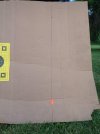Mikecr
Well-Known Member
Alignment and level are completely different things.
Also, the scope centerline does not 'have to' match action, or barrel, or stock, or rest, or ring, or turret, or raceway centerlines.
What matters -for level -is the scope's elevation,, and all else would be zero'd out.
For example:
If you purposely mounted a scope left of gun centerline by ~1", and set the scope elevation (either crosshair or dial) plumb with the real world (a distant plumb line), then elevation hold-offs or dialing will work just fine. The ~1" offset would taken out by horizontal bias in the scope(zero'd out). This would be horizontally dead nuts only at one distance and is less than preferred, but that is an ALIGNMENT issue, and not a LEVEL issue.
To suggest otherwise is to assume that a scope would be mounted purely in elevation alignment with everything except what matters (shooting that plumb line).
I used to shoot a competition gun setup for 600yds, with 7degs of cant. No problem, because the scope was NOT canted.
The way to set scope elevation plumb, regardless of all else, is to mount a level on the scope and set that level so that you can shoot a plumb line (through ~50moa of dialed vertical for me). The level has to be adjustable.
An example product to do this is the 'ScopLevel', which mounts on the scope itself. https://scopelevel.com/
Once set, you can move that scope from gun to gun & back, never having to reset it.
I used to have a standard scope (one known to be perfect) which was used for testing on probably 7-8 guns. I had a ScopLevel on it, calibrated with 1st use, and never had to mess with level for any gun I mounted that scope on.
Also, the scope centerline does not 'have to' match action, or barrel, or stock, or rest, or ring, or turret, or raceway centerlines.
What matters -for level -is the scope's elevation,, and all else would be zero'd out.
For example:
If you purposely mounted a scope left of gun centerline by ~1", and set the scope elevation (either crosshair or dial) plumb with the real world (a distant plumb line), then elevation hold-offs or dialing will work just fine. The ~1" offset would taken out by horizontal bias in the scope(zero'd out). This would be horizontally dead nuts only at one distance and is less than preferred, but that is an ALIGNMENT issue, and not a LEVEL issue.
To suggest otherwise is to assume that a scope would be mounted purely in elevation alignment with everything except what matters (shooting that plumb line).
I used to shoot a competition gun setup for 600yds, with 7degs of cant. No problem, because the scope was NOT canted.
The way to set scope elevation plumb, regardless of all else, is to mount a level on the scope and set that level so that you can shoot a plumb line (through ~50moa of dialed vertical for me). The level has to be adjustable.
An example product to do this is the 'ScopLevel', which mounts on the scope itself. https://scopelevel.com/
Once set, you can move that scope from gun to gun & back, never having to reset it.
I used to have a standard scope (one known to be perfect) which was used for testing on probably 7-8 guns. I had a ScopLevel on it, calibrated with 1st use, and never had to mess with level for any gun I mounted that scope on.
Last edited:

